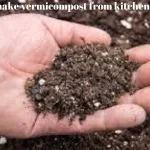how to make vemicompost from kitchen waste
how to make vermicompost from kitchen waste kitchen waste is an eco-friendly way to reduce landfill waste and create nutrient-rich fertilizer for your plants. Here’s how you can make kitchen waste compost using two 20-liter buckets:how to make vemicompost from kitchen waste
Introduction to Vermicomposting
Vermicomposting, also known as worm composting, is a process of using worms to decompose organic materials into nutrient-rich compost. It’s an efficient and environmentally friendly way to recycle kitchen scraps and other organic waste.
Materials Needed
how to make vermicompost from kitchen waste following materials:
- how to make vermicompost from kitchen waste
- Two 20-liter buckets
- Drill (for creating drainage holes)
- Kitchen waste (vegetable scraps, eggshells, fruit peels, etc.)
- Compost (to cover the waste and speed up decomposition)
- Effective Microorganisms (EM) solution (e.g., PSB – Photosynthetic Bacteria)
- Water
- black diamond vermicompost
Step-by-Step Guide to Building a Vermicompost Bin
- Preparing the Buckets
- Drill multiple holes in the bottom of one of the buckets to allow for drainage. This will prevent any excess liquid from leaking outside.
- Layering the Kitchen Waste
- Start by layering your kitchen waste into the bucket with drainage holes. Alternate between vegetable scraps, eggshells, fruit waste, etc. Ensure the waste is evenly spread out.
- Adding Compost and PSB Solution
- Cover the layer of kitchen waste with compost to speed up the decomposition process.
- Mix 3 bottle caps of PSB solution with 1.5 liters of water and pour it over the compost. PSB helps reduce bad smells and accelerates decomposition.
- Placement and Sun Exposure
- Place the compost bin in a sunny location to facilitate decomposition. The warmth of the sun will help break down the organic matter more quickly.
- Continuous Addition of Kitchen Waste
- Every 7 days, add more kitchen waste to the compost bin. Cover each new layer with compost to maintain the balance of green (nitrogen-rich) and brown (carbon-rich) materials.
- Regular Mixing
- Every 2 to 3 days, mix the contents of the compost bin to aerate it and speed up decomposition. This will also help distribute the beneficial microorganisms evenly.
- Harvesting the Liquid Fertilizer
- After 30 days, the compost should be ready for use. Dilute the liquid fertilizer with water at a ratio of 1:500 and apply it to all your plants. This nutrient-rich fertilizer will help nourish your plants and promote healthy growth.
- Final Application
- After 60 days, your kitchen waste compost will be fully mature and ready to be applied to all your plants. This organic fertilizer will enrich the soil and enhance the overall health of your garden.
Benefits of Vermicompost
Vermicompost offers numerous benefits for both your plants and the environment:
- It improves soil structure and fertility.
- It enhances plant growth and yields.
- It reduces the need for synthetic fertilizers.
- It minimizes greenhouse gas emissions from landfills.
Comparison: Vermicompost vs Worm Castings
While vermicompost and worm castings are both products of worm composting, there are some differences between the two:
- Vermicompost is the end product of the composting process, containing a mixture of decomposed organic materials and worm castings.
- Worm castings result from the digestive process of worms as they break down organic matter. They contain a dense concentration of nutrients and microbial activity.
Understanding NPK Content in Vermicompost
Vermicompost typically contains a balanced ratio of nitrogen (N), phosphorus (P), and potassium (K), as well as other essential micronutrients. The exact NPK content can vary depending on the feedstock used and the composting process.
Advantages and Disadvantages of Vermicompost
While vermicompost offers numerous benefits, there are also some drawbacks to consider:
- Advantages include improved soil health, increased plant growth, and reduced environmental impact.
- Disadvantages may include the initial setup cost, the need for regular maintenance, and potential odor issues.
Difference Between Compost and Vermicompost
While both compost and vermicompost are organic fertilizers, there are some key differences between the two:
- Compost is made through the decomposition of organic materials by microorganisms, whereas vermicompost involves the additional action of worms.
- Vermicompost tends to have higher microbial activity and nutrient availability compared to traditional compost.
How to Make Vermicompost from Different Sources
You can make vermicompost from various organic materials, including kitchen waste and cow dung. Here’s how:
- From Kitchen Waste:
- Collect kitchen scraps such as vegetable peelings, fruit scraps, and coffee grounds.
- Layer the waste in a vermicompost bin, covering each layer with bedding material like shredded newspaper or cardboard







